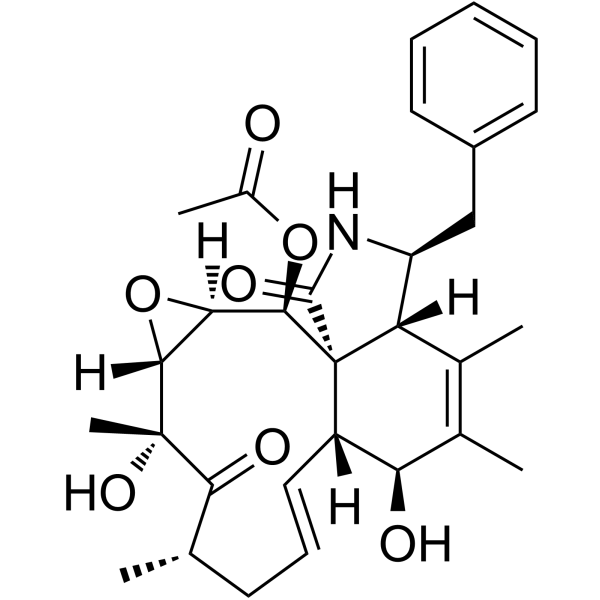189351-79-9
| Name | Epoxycytochalasin C, 19,20- |
|---|---|
| Synonyms |
19,20-Epoxycytochalasin C
3H-Oxireno[9,10]cycloundec[1,2-d]isoindole-3,13(4H)-dione, 14-(acetyloxy)-1a,2,5,7a,8,10a,11,12,14,14a-decahydro-2,8-dihydroxy-2,4,9,10-tetramethyl-11-(phenylmethyl)-, (1aR,2R,4S,6E,7aR,8S,10aR,11S,13aR,14aS)- (1aR,2R,4S,6E,7aR,8S,10aR,11S,13aR,14aS)-11-Benzyl-2,8-dihydroxy-2,4,9,10-tetramethyl-3,13-dioxo-2,3,4,5,7a,8,10a,11,12,13,14,14a-dodecahydro-1aH-oxireno[9,10]cycloundeca[1,2-d]isoindol-14-yl acetate |
| Description | 19,20-Epoxycytochalasin C, a cytochalasin, is a fungal metabolite from Nemania sp. 19,20-Epoxycytochalasin C shows potent in vitro antiplasmodial activity and phytotoxicity[1]. |
|---|---|
| Related Catalog | |
| Target |
Microbial Metabolite |
| In Vitro | 19,20-Epoxycytochalasin C shows moderate toxicity to cell line SK-MEL with an IC50 of 8.02 µM[1]. |
| In Vivo | Evaluation of in vivo antimalarial activity of 19,20-Epoxycytochalasin C in a mouse model at 100 mg/kg dose shows that this compound has weak suppressive antiplasmodial activity and is toxic to animals[1]. |
| References |
| Density | 1.3±0.1 g/cm3 |
|---|---|
| Boiling Point | 737.4±60.0 °C at 760 mmHg |
| Molecular Formula | C30H37NO7 |
| Molecular Weight | 523.617 |
| Flash Point | 399.7±32.9 °C |
| Exact Mass | 523.257019 |
| LogP | 3.64 |
| Vapour Pressure | 0.0±2.5 mmHg at 25°C |
| Index of Refraction | 1.610 |
